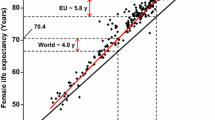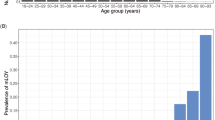Abstract
Age prediction is an important field in forensic and aging research. Traditional methods used DNA methylation, telomere shortening, and mitochondrial DNA mutations to conduct age prediction models. Sex chromosomes, like the Y chromosome, have a significant role in aging as previously reported in hematopoietic disease and many non-reproductive cancers. Until now, there is no age predictor based on the percentage of loss of Y chromosome (LOY). LOY has been previously revealed to be correlated with Alzheimer’s disease, short survival, and higher risk of cancer. The possible correlation of LOY between normal aging was not fully explored. In this study, we conducted age prediction by measuring LOY percentage by droplet digital PCR (ddPCR), based on 232 healthy male samples, including 171 blood samples, 49 saliva samples, 12 semen samples. The age group of samples ranges from 0 to 99 years, with two individuals in almost every single age. Pearson correlation method was performed to calculate the correlation index. The result indicated a correlation index of 0.21 (p = 0.0059) between age and LOY percentage in blood samples, with the regression formula being y = − 0.016823 + 0.001098x. The correlation between LOY percentage and age is obvious only when the individuals were divided into different age groups (R = 0.73, p = 0.016). In the studied saliva and semen samples, p-values of the correlation are 0.11 and 0.20, respectively, showing no significant association between age and LOY percentage in these two biological materials. For the first time, we investigated male-specific age predictor based on LOY. The study showed that LOY in leukocytes can be regarded as a male-specific age predictor for age group estimation in forensic genetics. This study might be indicative for forensic applications and aging research.







Similar content being viewed by others
Data availability
All relevant data are within the manuscript and its Supporting Information files. The code used for data processing was stored in Github (https://github.com/mengyuanSong/LOY/tree/main).
Abbreviations
- LOY:
-
Loss of Y chromosome
- ddPCR:
-
Droplet digital PCR
- MAD:
-
Mean absolute deviation
- FISH:
-
Fluorescence in situ hybridization
- CE:
-
Capillary electrophoresis
- AMOVA:
-
Analysis of molecular variance
- EDY:
-
Extreme downregulation of Y chromosome
- LOD:
-
Limit of detection
- AZF:
-
Azoospermia factors
- GOY:
-
Gain of Y chromosome
References
Barros B, Morais M, Teixeira AL, Medeiros R (2020) Loss of chromosome Y and Its Potential applications as biomarker in health and forensic sciences. Cytogenet Genome Res 160:225–237. https://doi.org/10.1159/000508564
Burki TK (2020) Association between extreme down-regulation of chromosome Y and cancer risk. Lancet Oncol 21:e72
Cáceres A, Jene A, Esko T et al (2020) Extreme downregulation of chromosome y and cancer risk in men. J Natl Cancer Inst 112:913–920. https://doi.org/10.1093/jnci/djz232
Cho S, Jung S, Rom S et al (2017) Forensic Science International : Genetics Independent validation of DNA-based approaches for age prediction in blood. Forensic Sci Int Genet 29:250–256. https://doi.org/10.1016/j.fsigen.2017.04.020
Danielsson M, Halvardson J, Davies H et al (2020) Longitudinal changes in the frequency of mosaic chromosome Y loss in peripheral blood cells of aging men varies profoundly between individuals. Eur J Hum Genet 28:349–357. https://doi.org/10.1038/s41431-019-0533-z
Dumanski JP, Rasi C, Lönn M et al (2015) Smoking is associated with mosaic loss of chromosome Y. Science 347:81–83. https://doi.org/10.1126/science.1262092
Forsberg LA, Rasi C, Malmqvist N et al (2014) Mosaic loss of chromosome y in peripheral blood is associated with shorter survival and higher risk of cancer. Nat Genet 46:624–628. https://doi.org/10.1038/ng.2966
Forsberg LA, Halvardson J, Rychlicka-Buniowska E et al (2019) Mosaic loss of chromosome Y in leukocytes matters. Nat Genet. https://doi.org/10.1038/s41588-018-0267-9
Giuliani C, Cilli E, Bacalini MG et al (2016) Inferring chronological age from DNA methylation patterns of human teeth. Am J Phys Anthropol. https://doi.org/10.1002/ajpa.22921
Guo X, Dai X, Zhou T et al (2020) Mosaic loss of human Y chromosome: what, how and why. Hum Genet 139:421–446. https://doi.org/10.1007/s00439-020-02114-w
Haupt S, Caramia F, Klein SL et al (2021) Sex disparities matter in cancer development and therapy. Nat Rev Cancer 21:393–407
Holmes RI, Keating MJ, Cork A et al (1985) Loss of the Y chromosome in acute myelogenous leukemia: a report of 13 patients. Cancer Genet Cytogenet 17:269–278. https://doi.org/10.1016/0165-4608(85)90018-4
Jacobs PA, Court Brown WM, Doll R (1961) Distribution of human chromosome counts in relation to age. Nature 191:1178–1180. https://doi.org/10.1038/1911178a0
Jacobs PA, Brunton M, Brown WMC et al (1963) Change of human chromosome count distributions with age: evidence for a sex difference. Nature 197:1080–1081. https://doi.org/10.1038/1971080a0
Ma Y, Kuang JZ, Zhang J et al (2012) Y chromosome interstitial deletion induced Y-STR allele dropout in AMELY-negative individuals. Int J Legal Med 126:713–724. https://doi.org/10.1007/s00414-012-0720-8
Nguyen AH, Bachtrog D (2021) Toxic Y chromosome: Increased repeat expression and age-associated heterochromatin loss in male Drosophila with a young Y chromosome. PLoS Genet. https://doi.org/10.1371/journal.pgen.1009438
Noveski P, Madjunkova S, Stefanovska ES et al (2016) Loss of Y chromosome in peripheral blood of colorectal and prostate cancer patients. PLoS ONE 11:1–10. https://doi.org/10.1371/journal.pone.0146264
Pierre RV, Hoagland HC (1972) Age-associated aneuploidy: Loss of Y chromosome from human bone marrow cells with aging. Cancer 30:889–894. https://doi.org/10.1002/1097-0142(197210)30:4%3c889::AID-CNCR2820300405%3e3.0.CO;2-1
Rajkumari S, Nirmal M, Sunil PM, Smith AA (2013) Estimation of age using aspartic acid racemisation in human dentin in Indian population. Forensic Sci Int 228:38–41. https://doi.org/10.1016/j.forsciint.2013.02.021
Richmond-Rakerd LS, D’Souza S, Andersen SH et al (2020) Clustering of health, crime and social-welfare inequality in 4 million citizens from two nations. Nat Hum Behav 4:255–264. https://doi.org/10.1038/s41562-019-0810-4
Rom S, Jung S, Hee E et al (2017) Forensic Science International : Genetics DNA methylation-based age prediction from saliva : high age predictability by combination of 7 CpG markers. Forensic Sci Int Genet 29:118–125. https://doi.org/10.1016/j.fsigen.2017.04.006
Schwender K, Holländer O, Klopfleisch S et al (2021) Development of two age estimation models for buccal swab samples based on 3 CpG sites analyzed with pyrosequencing and minisequencing. Forensic Sci Int Genet 53:102521. https://doi.org/10.1016/j.fsigen.2021.102521
United Kingdom Cancer Cytogenetics Group (1992) Loss of the Y chromosome from normal and neoplastic bone marrows. Genes Chromosom Cancer 5:83–88. https://doi.org/10.1002/gcc.2870050112
Vidaki A, González DM, Jiménez BP, Kayser M (2021) Male-specific age estimation based on Y-chromosomal DNA methylation. Aging 13:6442–6458. https://doi.org/10.18632/aging.202775
Wada M, Yokota J, Terada M et al (1987) Y chromosome abnormality in human stomach and lung cancer. Jpn J Cancer Res 78:780–783. https://doi.org/10.20772/cancersci1985.78.8_780
Wright DJ, Day FR, Kerrison ND et al (2017) Genetic variants associated with mosaic Y chromosome loss highlight cell cycle genes and overlap with cancer susceptibility. Nat Genet 49:674–679. https://doi.org/10.1038/ng.3821
Zapico SC, Ubelaker DH (2016) Relationship between mitochondrial DNA mutations and aging. Estimation of age-at-death. J Gerontol-Ser A Biol Sci Med Sci. https://doi.org/10.1093/gerona/glv115
Zhou W, Machiela MJ, Freedman ND et al (2016) Mosaic loss of chromosome Y is associated with common variation near TCL1A. Nat Genet. https://doi.org/10.1038/ng.3545
Acknowledgements
Thanks for the anonymous volunteers who provide samples. This work was supported by National Natural Science Foundation of China (grant numbers 82202614 and 81871532) and supported by the National Key Research and Development Program of China (No.2020YFC2005300). Thanks for the anonymous volunteers who provide samples.
Author information
Authors and Affiliations
Contributions
Conceptualization: MS; sample curation: MS, FS, XW; experiment: MS, FS; funding acquisition: YH; data analysis: MS, LJ, WZ, NW; supervision: FS, YH. Writing—original draft: MS; writing—review and editing: MS, WZ, NW, FS, YH. MS and FS conducted the experiment.
Corresponding authors
Ethics declarations
Conflict of interest
None.
Additional information
Communicated by Shuhua Xu.
Publisher's Note
Springer Nature remains neutral with regard to jurisdictional claims in published maps and institutional affiliations.
Supplementary Information
Below is the link to the electronic supplementary material.
Rights and permissions
Springer Nature or its licensor (e.g. a society or other partner) holds exclusive rights to this article under a publishing agreement with the author(s) or other rightsholder(s); author self-archiving of the accepted manuscript version of this article is solely governed by the terms of such publishing agreement and applicable law.
About this article
Cite this article
Song, M., Jiang, L., Wang, X. et al. Loss of Y chromosome in leukocytes can be regarded as a male-specific age predictor for age group estimation in forensic genetics. Mol Genet Genomics 298, 1073–1085 (2023). https://doi.org/10.1007/s00438-023-02039-9
Received:
Accepted:
Published:
Issue Date:
DOI: https://doi.org/10.1007/s00438-023-02039-9




